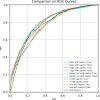Predicting venous thromboembolism in hospitalized trauma patients: a combination of the Caprini score and data-driven machine learning model
- PMID: 33971809
- PMCID: PMC8111727
- DOI: 10.1186/s12873-021-00447-x
Predicting venous thromboembolism in hospitalized trauma patients: a combination of the Caprini score and data-driven machine learning model
Abstract
Background: Venous thromboembolism (VTE) is a common complication of hospitalized trauma patients and has an adverse impact on patient outcomes. However, there is still a lack of appropriate tools for effectively predicting VTE for trauma patients. We try to verify the accuracy of the Caprini score for predicting VTE in trauma patients, and further improve the prediction through machine learning algorithms.
Methods: We retrospectively reviewed emergency trauma patients who were admitted to a trauma center in a tertiary hospital from September 2019 to March 2020. The data in the patient's electronic health record (EHR) and the Caprini score were extracted, combined with multiple feature screening methods and the random forest (RF) algorithm to constructs the VTE prediction model, and compares the prediction performance of (1) using only Caprini score; (2) using EHR data to build a machine learning model; (3) using EHR data and Caprini score to build a machine learning model. True Positive Rate (TPR), False Positive Rate (FPR), Area Under Curve (AUC), accuracy, and precision were reported.
Results: The Caprini score shows a good VTE prediction effect on the trauma hospitalized population when the cut-off point is 11 (TPR = 0.667, FPR = 0.227, AUC = 0.773), The best prediction model is LASSO+RF model combined with Caprini Score and other five features extracted from EHR data (TPR = 0.757, FPR = 0.290, AUC = 0.799).
Conclusion: The Caprini score has good VTE prediction performance in trauma patients, and the use of machine learning methods can further improve the prediction performance.
Keywords: Machine learning; Models, statistical; Risk assessment; Venous thromboembolism; Wounds and injuries.
Conflict of interest statement
The authors declare that they have no competing interests.
Figures





References
-
- Heit JA, Cohen AT, Anderson FA Jr, Group oBotVIA. Estimated Annual Number of Incident and Recurrent, Non-Fatal and Fatal Venous Thromboembolism (VTE) Events in the US. Blood. 2005;106(11):910. 10.1182/blood.V106.11.910.910.
MeSH terms
LinkOut - more resources
Full Text Sources
Other Literature Sources
Medical

